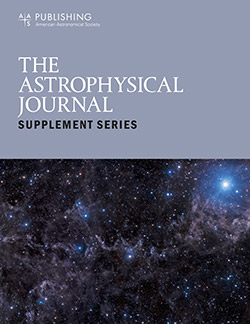黄道极无遮挡qso的光度选择:南场KMTNet和北场Pan-STARRS
IF 8.5
1区 物理与天体物理
Q1 ASTRONOMY & ASTROPHYSICS
引用次数: 0
摘要
我们在南黄道极(SEP)场的广阔区域寻找准恒星天体(qso),这一领域已经并将继续通过各种太空任务得到深入探索。为此,我们利用韩国微透镜望远镜网络(KMTNet)获得了覆盖面积为~ 14.5 × 14.5°2的SEP场的深宽带光学图像。BVRI波段点源的5 σ检出限分别为~ 22.59、22.60、22.98和21.85等。利用宽视场红外巡天探测器的数据,使用中红外(MIR)和光学MIR颜色从光学点状光源中选择无遮挡的QSO候选者。为了进一步完善我们的选择并消除任何未被基于颜色的选择充分去除的污染,我们使用从光学到MIR的档案光度数据进行光谱能量分布拟合。结果,我们在SEP领域共识别了2383个未遮挡的QSO候选分子。我们还利用Pan-STARRS数据对北黄道极场应用了类似的方法,获得了2427个候选点的相似结果。我们的候选QSO的每个区域的差分数与其他领域的光谱确认的测量值很好地一致。最后,我们将结果与文献进行比较,并讨论这项工作将如何影响未来的研究,特别是即将到来的太空任务。本文章由计算机程序翻译,如有差异,请以英文原文为准。
Photometric Selection of Unobscured QSOs at the Ecliptic Poles: KMTNet in the South Field and Pan-STARRS in the North Field
Abstract We search for quasi-stellar objects (QSOs) in a wide area of the south ecliptic pole (SEP) field, which has been and will continue to be intensively explored through various space missions. For this purpose, we obtain deep broadband optical images of the SEP field covering an area of ∼14.5 × 14.5 deg 2 with the Korea Microlensing Telescope Network (KMTNet). The 5 σ detection limits for point sources in the BVRI bands are estimated to be ∼22.59, 22.60, 22.98, and 21.85 mag, respectively. Utilizing data from the Wide-field Infrared Survey Explorer, unobscured QSO candidates are selected among the optically pointlike sources using mid-infrared (MIR) and optical–MIR colors. To refine our selection further and eliminate any contamination not adequately removed by the color-based selection, we perform spectral energy distribution fitting with archival photometric data ranging from optical to MIR. As a result, we identify a total of 2383 unobscured QSO candidates in the SEP field. We also apply a similar method to the north ecliptic pole field using Pan-STARRS data and obtain a similar result of identifying 2427 candidates. The differential number count per area of our QSO candidates is in good agreement with those measured from spectroscopically confirmed ones in other fields. Finally, we compare the results with the literature and discuss how this work will impact future studies, especially upcoming space missions.
求助全文
通过发布文献求助,成功后即可免费获取论文全文。
去求助
来源期刊

Astrophysical Journal Supplement Series
地学天文-天文与天体物理
CiteScore
14.50
自引率
5.70%
发文量
264
审稿时长
2 months
期刊介绍:
The Astrophysical Journal Supplement (ApJS) serves as an open-access journal that publishes significant articles featuring extensive data or calculations in the field of astrophysics. It also facilitates Special Issues, presenting thematically related papers simultaneously in a single volume.
 求助内容:
求助内容: 应助结果提醒方式:
应助结果提醒方式:


